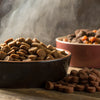What's Better for Dogs: Wet or Dry Food?
- Houndsy
Table of Contents
- Introduction
- Understanding Wet and Dry Dog Food
- Comparing the Nutritional Aspects
- Key Benefits of Wet and Dry Dog Food
- Potential Drawbacks of Each Type
- Mixing Wet and Dry Dog Food
- Special Considerations in Choosing Dog Food
- Conclusion
Introduction
Every dog owner has been there—standing in the pet food aisle, bombarded by countless options, each promising to be the best for our furry companions. Have you ever noticed the abundance of choices between wet and dry dog food? With statistics showing that over 68% of dog owners experience confusion regarding kibble and canned options, it’s hardly surprising that many pet parents are left wondering, what's better for dogs: wet or dry food?
This post dives deep into the nuanced world of dog food, aiming to provide you with clear insights that will enhance the feeding experience for both you and your pet. We’ll explore the fundamental differences between wet and dry foods, their respective advantages and disadvantages, and how to decide what might work best for your dog. By the end, you’ll be equipped with the knowledge to make an informed decision that fits your dog's needs and lifestyle.
Additionally, we’ll highlight our very own Houndsy Kibble Dispenser, which helps you serve both wet and dry food conveniently, making the feeding experience perfect for you and your furry friend. So, let’s embark on this journey to better feeding habits and discover what suits our beloved pooches the best.
Understanding Wet and Dry Dog Food
What is Dry Dog Food?
Dry dog food, often referred to as kibble, is a staple in many households due to its convenience and longevity. Its low moisture content—averaging around 10%—means it can be stored easily, making it a practical choice for everyday feeding. The manufacturing process involves cooking the ingredients and extruding them into kibble, creating a crunchy texture that many dogs enjoy.
Key Features of Dry Dog Food:
- Convenience: Dry food can be portioned easily and stored for an extended time without spoiling.
- Dental Benefits: The crunchy texture aids in scraping away plaque, contributing to better dental health.
- Cost-Effective: Generally, dry food is less expensive than its wet counterparts, especially in bulk.
What is Wet Dog Food?
Wet dog food, also known as canned food, has much higher moisture content—typically between 75% and 84%. It usually comes in pouches or cans and is made using a different process that involves cooking and sealing the food in airtight containers. This method preserves flavors and aromas, making wet food particularly appealing to many dogs.
Key Features of Wet Dog Food:
- High Moisture Content: Excellent for dogs that may not drink enough water throughout the day.
- Palatability: The rich aroma and soft texture can entice picky eaters or those with health issues.
- Easier to Chew: Ideal for older dogs or those with dental problems, as it’s softer than kibble.
Comparing the Nutritional Aspects
When it comes to nutrition, both wet and dry dog foods can be balanced and provide essential nutrients. However, their nutrient profiles can differ significantly, affecting your decision.
Protein Content
- Dry Food typically has a higher protein density on a dry matter basis—ranging from 25% to 40%. This density makes it more nutrient-dense since water weight is minimal.
- Wet Food usually contains higher moisture, resulting in lower protein percentages (around 10% to 15%). However, this varies by brand and formulation, so it’s vital to look for high-quality options for both types.
Fat Content
Both wet and dry foods contain fats essential for energy and nutrient absorption. Typically:
- Dry food includes fats around 5% to 15%.
- Wet food may have slightly higher levels depending on added fat sources but is generally similar.
Carbohydrate Levels
Dry Food often has a higher carbohydrate content (30% to 50%) to provide energy and help bind the kibble. In contrast, wet food usually comprises fewer carbs (10% to 30%), focusing more on protein sources.
Key Benefits of Wet and Dry Dog Food
Choosing between wet and dry food involves weighing the benefits of each. Here’s a breakdown that can help guide your decision.
Benefits of Wet Dog Food
-
Hydration Support: Higher moisture content contributes to better hydration, especially beneficial for dogs with kidney issues or those that don’t drink much water.
-
Taste and Appetite: The enhanced aroma and flavor can entice even the pickiest eaters, encouraging better food intake, especially in stressful situations such as illness or travel.
-
Digestibility: Softer food is easier to chew and may be better tolerated by dogs with sensitive stomachs or dental issues.
-
Satiety: Many wet foods can help your dog feel fuller for longer, assisting with weight management.
Benefits of Dry Dog Food
-
Dental Health: The crunchy kibble can aid in reducing plaque and tartar buildup, promoting dental health.
-
Convenience and Portability: Easy to measure out and can be left in a bowl without spoiling quickly, making it a convenient option for busy pet owners.
-
Cost Efficiency: Typically less expensive and can be stored for long periods, offering better value.
-
Variety in Feeding: Kibble can be used in interactive feeding toys, facilitating cognitive stimulation and play.
Potential Drawbacks of Each Type
Understanding the downsides can help you make a more comprehensive decision.
Drawbacks of Wet Dog Food
- Messier Eating Experience: Wet food can be messier; it may lead to residue on your dog’s face and bowl.
- Shorter Shelf Life: Once opened, it must be consumed quickly to prevent spoilage.
- Higher Cost: Generally more expensive than dry food, potentially leading to increased costs for large dogs.
Drawbacks of Dry Dog Food
- Lower Moisture Content: This may not meet the hydration needs of all dogs, especially those prone to urinary issues.
- Less Appealing to Some Dogs: Some dogs may find dry food less exciting compared to its wet counterparts.
- Potential for Higher Carbohydrate Levels: This could be an issue for dogs with certain dietary needs or weight management concerns.
Mixing Wet and Dry Dog Food
For many pet owners, the solution lies in combining wet and dry food to combine the benefits of both. Mixing can enhance taste while providing moisture, leading to a well-rounded diet.
Benefits of Mixing:
- Increased Palatability: The addition of wet food can make dry kibble more enticing.
- Heightened Nutritional Variety: A diverse diet can contribute to better overall health.
- Enhanced Hydration: The moisture from wet food can help dogs who habitually drink insufficient water.
When choosing to mix, it’s crucial to establish a balanced ratio and continuously monitor your dog's reactions to ensure they’re happy and healthy.
Special Considerations in Choosing Dog Food
Age and Health Conditions
- Puppies: They may benefit from either wet or dry food, but wet food can ease the transition from mother's milk to solid food.
- Active Dogs: High-quality dry food may suit energetic dogs more due to its density.
- Senior Dogs: Wet food might provide easier consumption and digestion for older dogs.
Dietary Restrictions
If your dog has medical conditions—like diabetes, obesity, or kidney problems—it’s always best to consult a veterinarian. They can help tailor a diet that meets your dog's specific needs.
Conclusion
In the great debate of what's better for dogs: wet or dry food?, there truly is no one-size-fits-all answer. Both types provide valuable nutrition and unique benefits, and the best choice ultimately hinges on your dog's health, preferences, and lifestyle.
Reflective questions to ponder as you decide:
- How does your dog react during mealtime—do they seem enthusiastic about what they eat?
- Are there any noticeable health concerns impacting your dog's appetite or hydration?
- Have you considered the benefits of mixing both wet and dry foods for added variety?
Additionally, having a knowledgeable feeding routine can enhance your overall pet care experience. To simplify your dog-feeding experience while maintaining a modern aesthetic, consider exploring the Houndsy Kibble Dispenser. Our dispenser not only allows for perfect portion control but also seamlessly integrates into your home decor, making your feeding ritual an elegant affair.
FAQ
Can I mix wet and dry dog food?
Yes! Mixing wet and dry food can enhance palatability and provide the benefits of both types. Just ensure you monitor the portion sizes to prevent overfeeding.
Which is better for puppies, wet or dry food?
Wet food is often better for puppies as it is easier to chew and digest. However, high-quality dry food formulated for puppies can also be nutritionally adequate.
How can I transition my dog from wet to dry food?
Transition your dog slowly over 5-10 days by gradually incorporating the new food, mixing it with their current diet to avoid any digestive distress.
Should I feed my older dog wet food?
Wet food can be beneficial for senior dogs due to its higher moisture content, which helps with hydration and is typically softer for easier consumption.
What should I look for in a high-quality dog food?
Look for high protein content, quality ingredients (meat as the first ingredient), minimal fillers, and avoid artificial preservatives and by-products. Always consult your veterinarian to ensure you choose the best option for your dog's specific needs.












